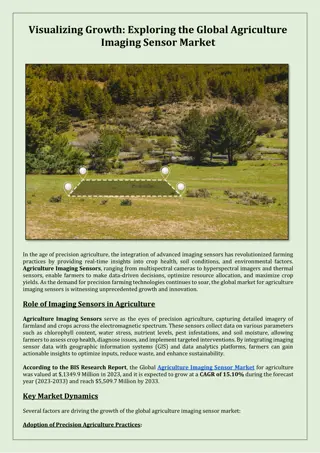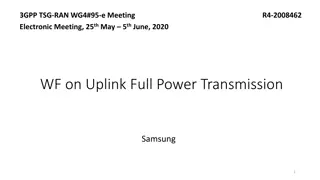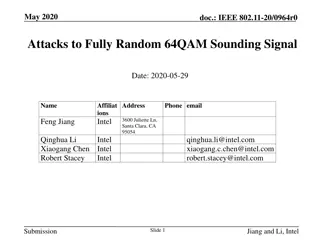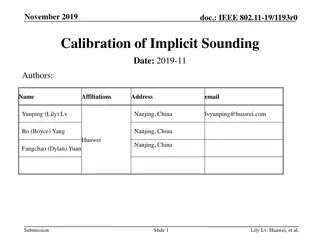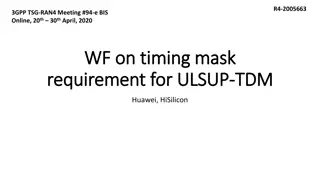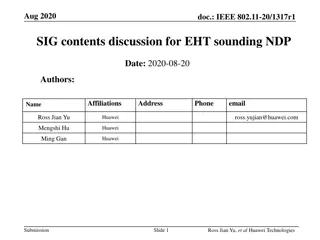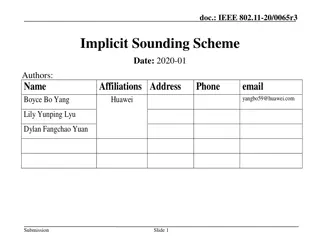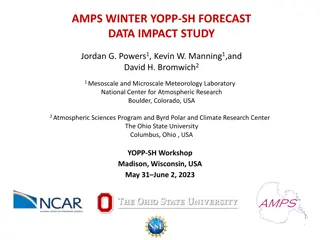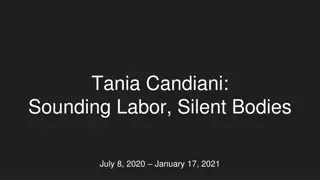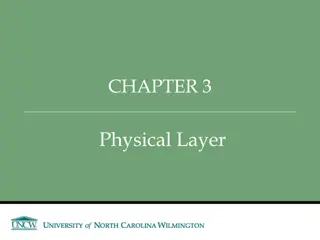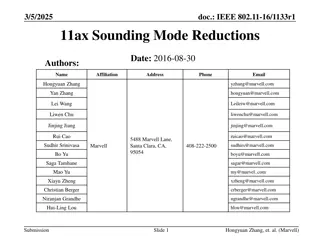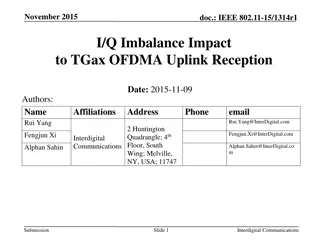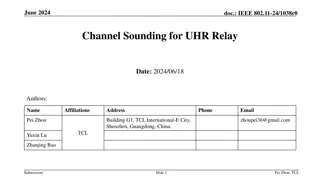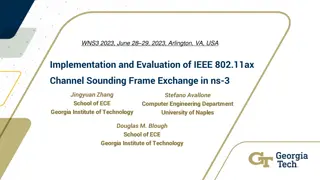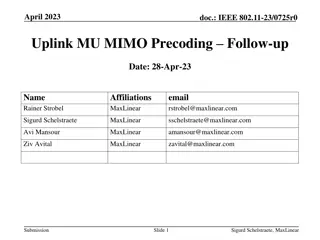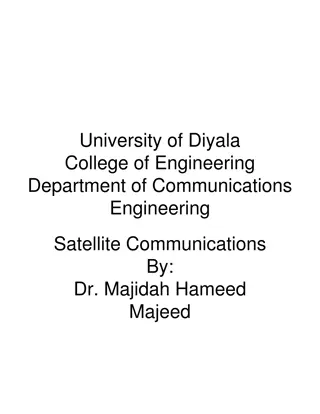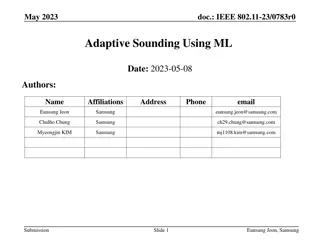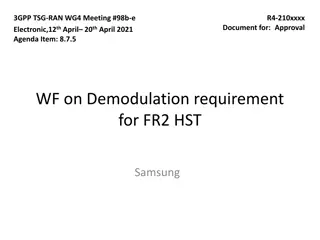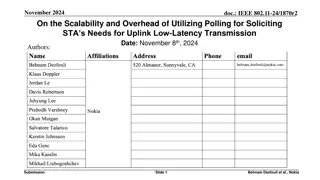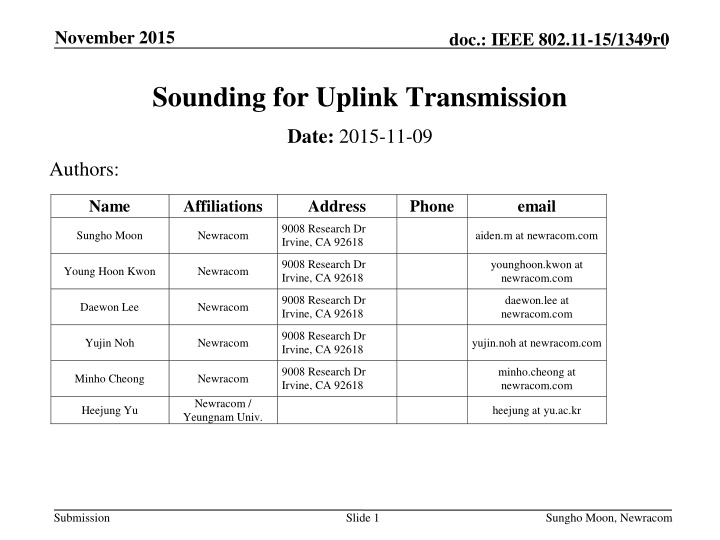
Enhancing Uplink Transmission Efficiency in IEEE 802.11 Networks
Explore the necessity of uplink channel sounding in IEEE 802.11 networks to optimize transmission efficiency. Learn about using existing sequences for UL data transmission and the importance of beamforming. Understand the challenges faced by STAs in estimating CSI for uplink channels and the proposed solutions for improved performance.
Download Presentation

Please find below an Image/Link to download the presentation.
The content on the website is provided AS IS for your information and personal use only. It may not be sold, licensed, or shared on other websites without obtaining consent from the author. If you encounter any issues during the download, it is possible that the publisher has removed the file from their server.
You are allowed to download the files provided on this website for personal or commercial use, subject to the condition that they are used lawfully. All files are the property of their respective owners.
The content on the website is provided AS IS for your information and personal use only. It may not be sold, licensed, or shared on other websites without obtaining consent from the author.
E N D
Presentation Transcript
November 2015 doc.: IEEE 802.11-15/1349r0 Sounding for Uplink Transmission Date: 2015-11-09 Authors: Name Affiliations Address Phone email 9008 Research Dr Irvine, CA 92618 Sungho Moon Newracom aiden.m at newracom.com 9008 Research Dr Irvine, CA 92618 younghoon.kwon at newracom.com Young Hoon Kwon Newracom 9008 Research Dr Irvine, CA 92618 daewon.lee at newracom.com Daewon Lee Newracom 9008 Research Dr Irvine, CA 92618 Yujin Noh Newracom yujin.noh at newracom.com 9008 Research Dr Irvine, CA 92618 minho.cheong at newracom.com Minho Cheong Newracom Newracom / Yeungnam Univ. Heejung Yu heejung at yu.ac.kr Submission Slide 1 Sungho Moon, Newracom
November 2015 doc.: IEEE 802.11-15/1349r0 Background The SFD defines a new channel sounding sequence to multiplex the Compressed Beamforming Action frame (CSI feedback) However, it can be used to measure downlink channel, i.e., channel from an AP to STAs, and there is no sounding sequence for uplink channel This contribution is talking about UL sounding sequence, i.e. to measure uplink channels from STAs to an AP Submission Slide 2 Sungho Moon, Newracom
November 2015 doc.: IEEE 802.11-15/1349r0 Necessity of UL Sounding Multiple Tx. antennas in STA are more popular than before, and thus the beamforming for UL transmission is necessary In the narrow band transmission such as UL OFDMA, the beamforming is more important to achieve frequency selective gains from the cost of diversity gain in wideband transmission However, STAs have limited ways to estimate CSI of uplink channel For example, a STA doesn t have enough capability of Tx/Rx calibration to perform implicit uplink CSI estimates from downlink Therefore, a feasible way to measure uplink CSI is to perform a sounding procedure for uplink channel Submission Slide 3 Sungho Moon, Newracom
November 2015 doc.: IEEE 802.11-15/1349r0 UL Sounding of the Existing Sequence Without AP s TXOP, each STA can use the existing 11ac sounding sequence Each STA will send NDP-A and NDP frames sequentially through contentions and receive a CB from the AP Using the received CB, the STA can beamform and send its UL data or wait for a Trigger frame for UL MU transmission After contentions, another STA can perform the same sounding for an UL transmission SIFS Contentions Comp BF for STA1 Comp BF for STA2 AP (beamformee) SIFS SIFS NDP NDP-A STA1 (beamformer1) SIFS NDP-A NDP STA2(beamformer2) Submission Slide 4 Sungho Moon, Newracom
November 2015 doc.: IEEE 802.11-15/1349r0 UL Sounding with AP s Control With an AP s TXOP, an UL sounding may be needed before a Trigger frame The AP can initiate an UL MU transmission by sending a Trigger frame, and each STA may need a CB for beamforming before receiving the Trigger frame TXOP holder Trigger frame AP (beamformee) UL Sounding may be needed before a Trigger frame UL MU STA1 (beamformer1) UL MU STA2(beamformer2) However, the current 11ac sounding sequence is initiated by a beamformer (STA in uplink), not by a beamformee (AP), and thus the AP (TXOP holder) can t control the UL sounding sequence if the existing 11ac mechanism is reused Submission Slide 5 Sungho Moon, Newracom
November 2015 doc.: IEEE 802.11-15/1349r0 Requirements for UL Sounding Sequence Within a TXOP of AP, AP should initiate a UL sounding sequence(s) Since a UL MU transmission is started from AP s trigger frame, the AP should have the controllability of UL sounding as well Remove unnecessary frame exchanges in a sequence(s) For example, there is only one beamformee (AP) and thus, most of information in NDP-A sent by multiple beamfomers (STAs) will be the same or unnecessary. Therefore, multiple NDP-A frames sent by STAs can be merged or omitted Reduce the air-time of the entire sequence Multiple NDP-A or NDP frames can be multiplexed as an MU transmission Before starting an UL sounding, AP may know preferred subband or spatial streams for each STA, and then NDP can be multiplexed in UL MU Submission Slide 6 Sungho Moon, Newracom
November 2015 doc.: IEEE 802.11-15/1349r0 Example of UL Sounding An AP initiates a sounding procedure by sending a specific sounding trigger frame Each STA sends NDP frames to the AP in the UL MU manner as a response of the sounding trigger frame Most of information for NDP-A can be included in the UL sounding trigger frame, and in this case, NDP-A frames sent by STAs are not necessary NDPA + NDP Or just NDP UL sounding Trigger frame TXOP holder AP (beamformee) NDP-A NDP STA1 (beamformer1) NDP-A NDP STA2(beamformer2) Submission Slide 7 Sungho Moon, Newracom
November 2015 doc.: IEEE 802.11-15/1349r0 Conclusion The beamforming is needed even in UL MU transmissions due to more popular multiple Tx. antennas in a STA The UL sounding using the existing 11ac sounding sequence will cause large overhead because multiple beamformers are involved in a UL MU transmission HE needs a new UL sounding sequence which is initiated by an AP Further discussion will be needed for details of the UL sounding sequence Submission Slide 8 Sungho Moon, Newracom
November 2015 doc.: IEEE 802.11-15/1349r0 Straw Poll #1 Do you agree to add the following texts into SFD? AP may initiate uplink sounding sequence. Submission Slide 9 Sungho Moon, Newracom

